23 Best Things to See and Do in Nara
Discover the best things to see and do in Nara, an enchanting city steeped in history and culture. As one of Japan’s ancient capitals and home to numerous cultural treasures, Nara offers visitors an abundance of attractions to discover. Here are the 23 best things to do in Nara on a day trip or short stay:
1. Feed the Deer in Nara Park
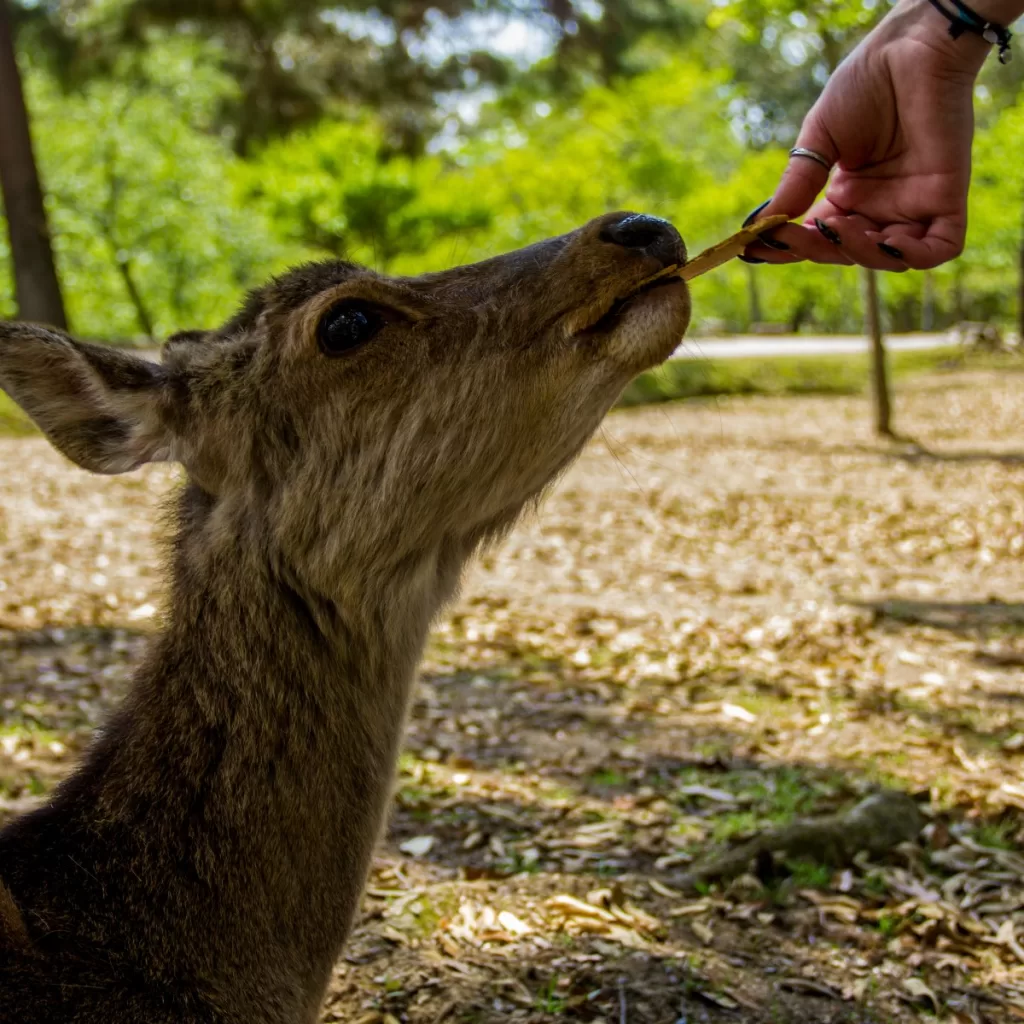
One of the best things to do in Nara is feed the over 1,000 deer that roam freely in Nara Park. These deer are surprisingly tame and will even bow to ask for deer crackers. It’s fun to get up close with the deer and feed them right out of your hand.
Feeding the Deer in Nara Park is a delightful and unique experience that has become a highlight for many visitors to Japan. As the heart of Nara, the park is a designated wildlife sanctuary where hundreds of freely roaming deer reside, creating a harmonious blend of nature and culture.
Nara Park, also known as Deer Park, covers a vast area of 502 hectares and is located right in the center of the city. Nara deer park is a must-visit attraction when exploring around Nara. The park is not only famous for its sprawling green spaces and scenic beauty but also for its large population of friendly and approachable deer.
According to Nara travel guides, feeding the deer is not only allowed but also encouraged, as these creatures hold a special place in the city’s culture and history. The deer are protected as natural treasures and considered sacred messengers of the Kasuga Taisha Shrine, which is located within the park.
For those who choose to stay in Nara, interacting with the deer in the park offers a unique opportunity to get up close and personal with these gentle creatures. Vendors throughout the park sell special crackers called “shika senbei” that are meant for feeding the deer. Visitors can purchase these crackers and enjoy the heartwarming experience of hand-feeding the deer.
2. See Todaiji Temple and the Great Buddha

Located in Nara, Todaiji Temple and the Great Buddha are iconic landmarks that should not be missed on a Nara day trip. It is considered a UNESCO World Heritage Site.
Todaiji Temple is one of the most well known temples in Japan and home to the world’s largest bronze Buddha statue. The Daibutsuden (Big Buddha Hall) is the largest wooden building in the world and houses the massive 15 m-tall Great Buddha statue. It’s an impressive sight and one of the highlights of visiting Nara.
Visiting Todaiji Temple and witnessing the Great Buddha is one of the top things to do in Nara. The statue itself is a masterpiece, standing at a towering height of around 15 meters and crafted from bronze. Stepping into the Daibutsuden, you’ll be awestruck by the grandeur and sheer scale of the Great Buddha, an awe-inspiring sight that leaves a lasting impression.
3. Explore Kofukuji Temple
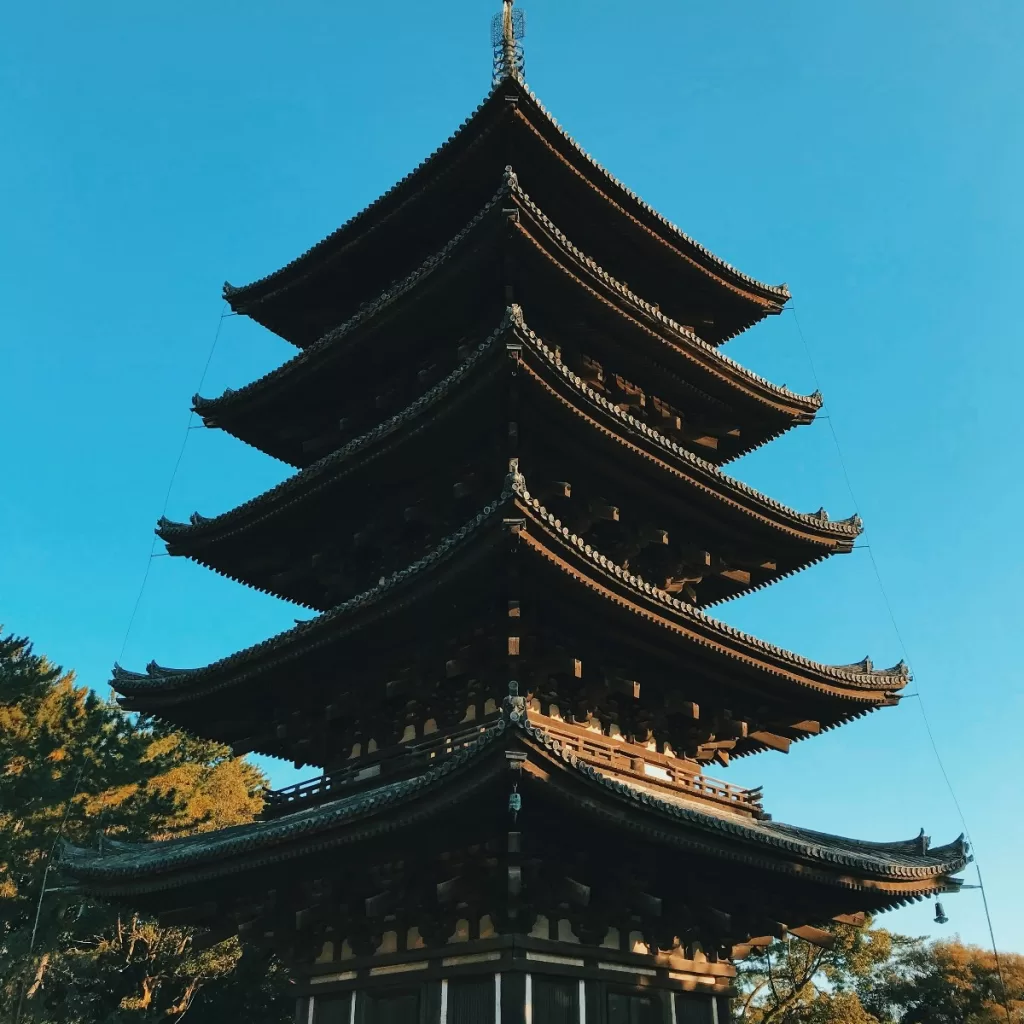
One of the must-see attractions in Nara is Kofukuji Temple. Kofuku-ji temple is an important Buddhist temple that once rivaled Todaiji in power. The temple was established in 710 AD. The complex has a five-story pagoda, treasure hall, and extensive grounds to walk through. It showcases classic Buddhist architecture.
Kofukuji Temple is a prominent symbol of the city. Its striking five-story pagoda stands tall, creating an impressive sight that can be seen from various points around Nara. The temple complex dates back to the 8th century and holds immense historical significance.
The best time to visit Kofukuji Temple is during the spring and autumn seasons, when the surrounding foliage provides a stunning backdrop of cherry blossoms or vibrant autumn colors. These seasons enhance the beauty of the temple and create a picturesque atmosphere, making it an ideal time for photography or simply soaking in the serene ambiance.
4. Visit Kasuga Taisha Grand Shrine

One of the best places to explore in Nara is the Kasuga Taisha Grand Shrine. Kasuga Taisha is Nara’s most important Shinto shrine. It was established in 768 AD and protects the city. Walk along the forested pathways lined with 3,000 lanterns. The shrine buildings have vivid vermilion colors and ornate wood carvings.
As one of the most important tourist attractions in Nara, visiting Kasuga Taisha offers a glimpse into traditional Japanese architecture and religious practices. The shrine’s striking vermilion color and the stone lanterns that line the approach create a captivating atmosphere, especially when visited during the cherry blossom season in spring or autumn when the surrounding forest is ablaze with vibrant colors.
Considered one of the best times to visit Japan, the cherry blossom season adds an extra touch of beauty and charm to Kasuga Taisha. The shrine is particularly known for its role in the Kasuga Wakamiya On-matsuri festival, held annually in February, where lanterns are lit throughout the shrine, creating a magical sight.
5. Stroll through Nara Park
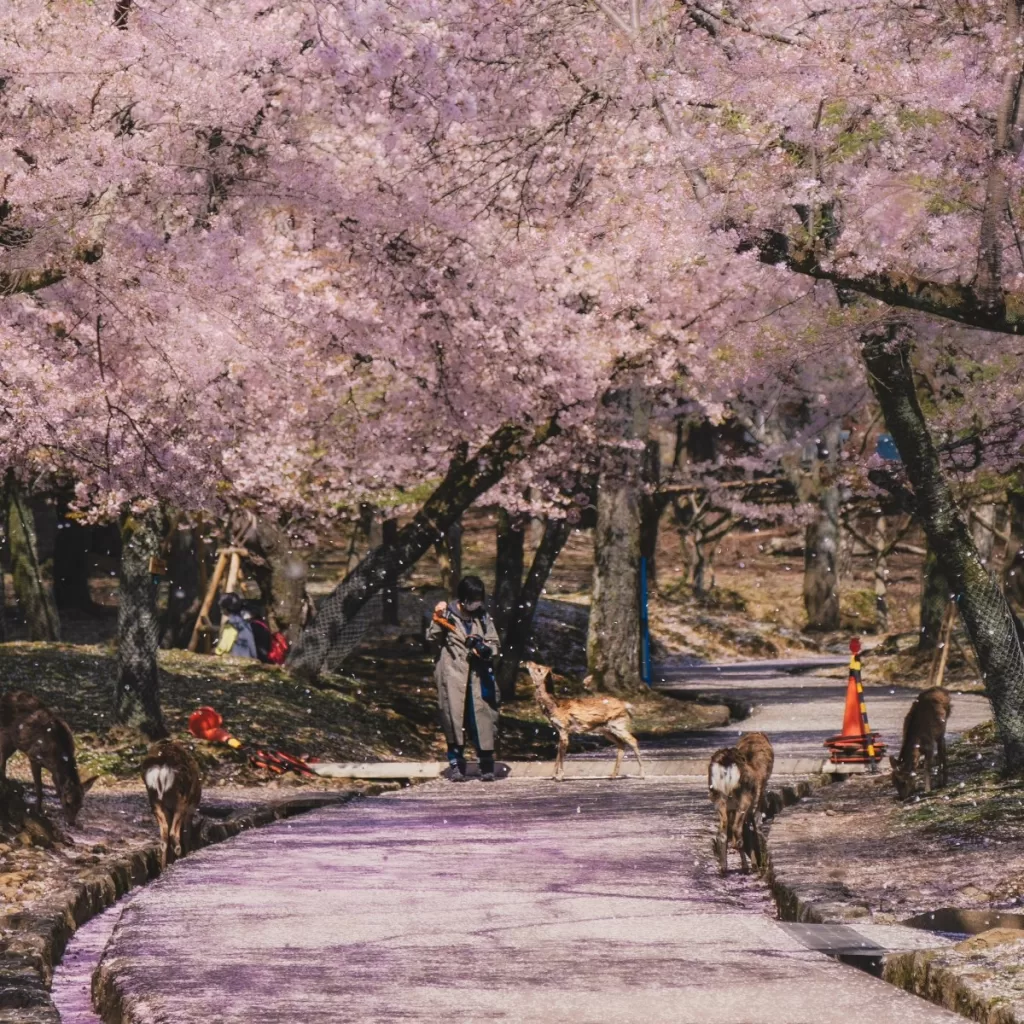
One of the best places to visit and explore in Nara is the famous Nara Park. Spread across a vast area, this expansive park is home to numerous attractions and sites in Nara.
Strolling through Nara Park presents a host of unique things to see and experience. One of the most remarkable and charming aspects of the park is the presence of friendly deer that roam freely throughout the area.
Nara Park covers over 500 hectares and encompasses many of Nara’s top attractions, like Todaiji and Kasuga Taisha. There are tame deer throughout the grounds, as well as scenic ponds and gardens to see. It’s pleasant to walk through the massive park.
Moreover, behind Nara Park lies a wealth of historical and cultural attractions. As you traverse the park, you can discover great temples in Nara. These temples offer a glimpse into Nara’s rich heritage and are a testament to the city’s significance as an ancient capital of Japan.
6. Explore Naramachi Neighborhood
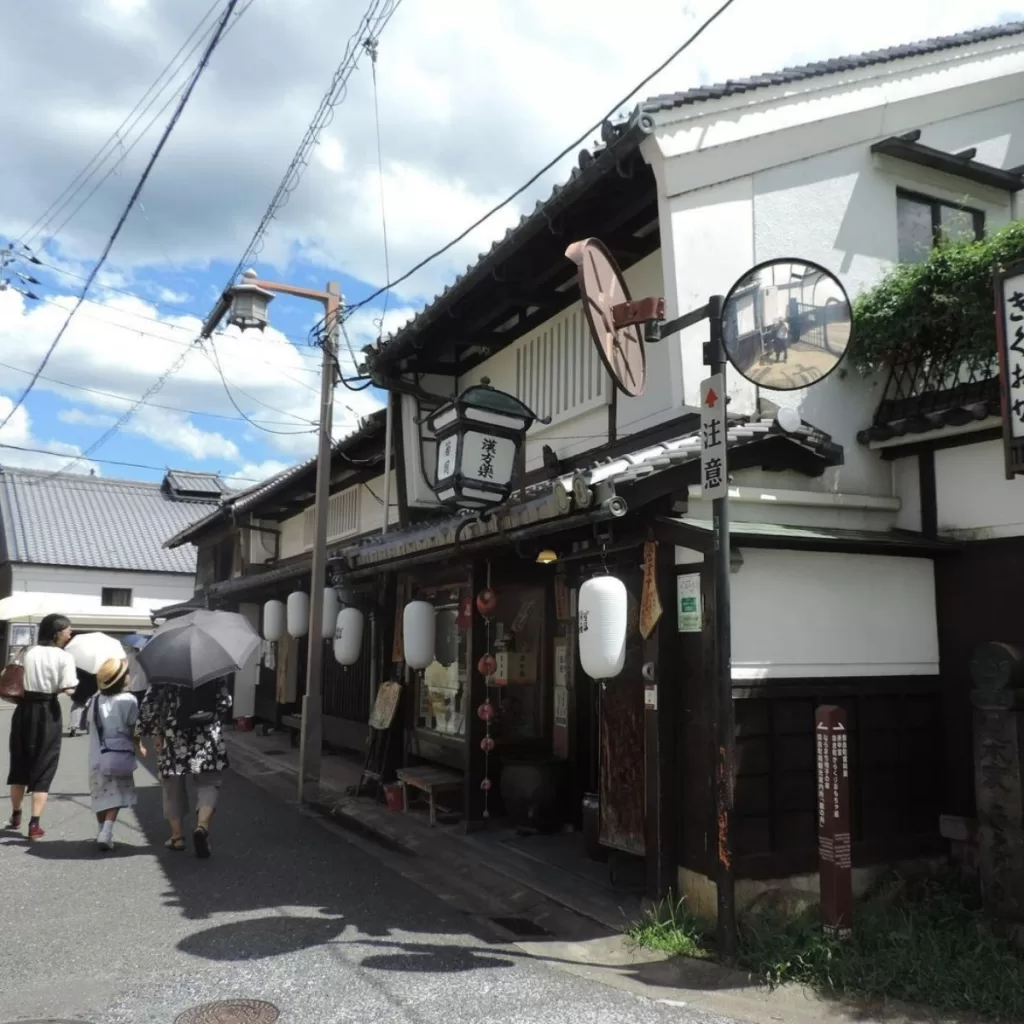
Naramachi is a traditional district with narrow lanes lined with wooden machiya merchant houses. Many residences now house cafes, galleries, and craft shops. It gives you a feel for historic Nara city.
Wandering through Naramachi allows visitors to immerse themselves in the charm of old Japan. The neighborhood is known for its well-preserved machiya houses, traditional wooden townhouses that line the streets. These machiya have been converted into cafes, shops, and museums, offering a unique blend of old-world aesthetics and modern amenities.
During the spring and autumn seasons, Naramachi’s streets are adorned with beautifully blooming cherry blossoms or colorful leaves, enhancing the allure of exploring the neighborhood. The best way to experience the charm of Naramachi is to take a leisurely stroll through its winding streets, following your curiosity and allowing yourself to be immersed in its unique atmosphere.
7. See the Nara National Museum
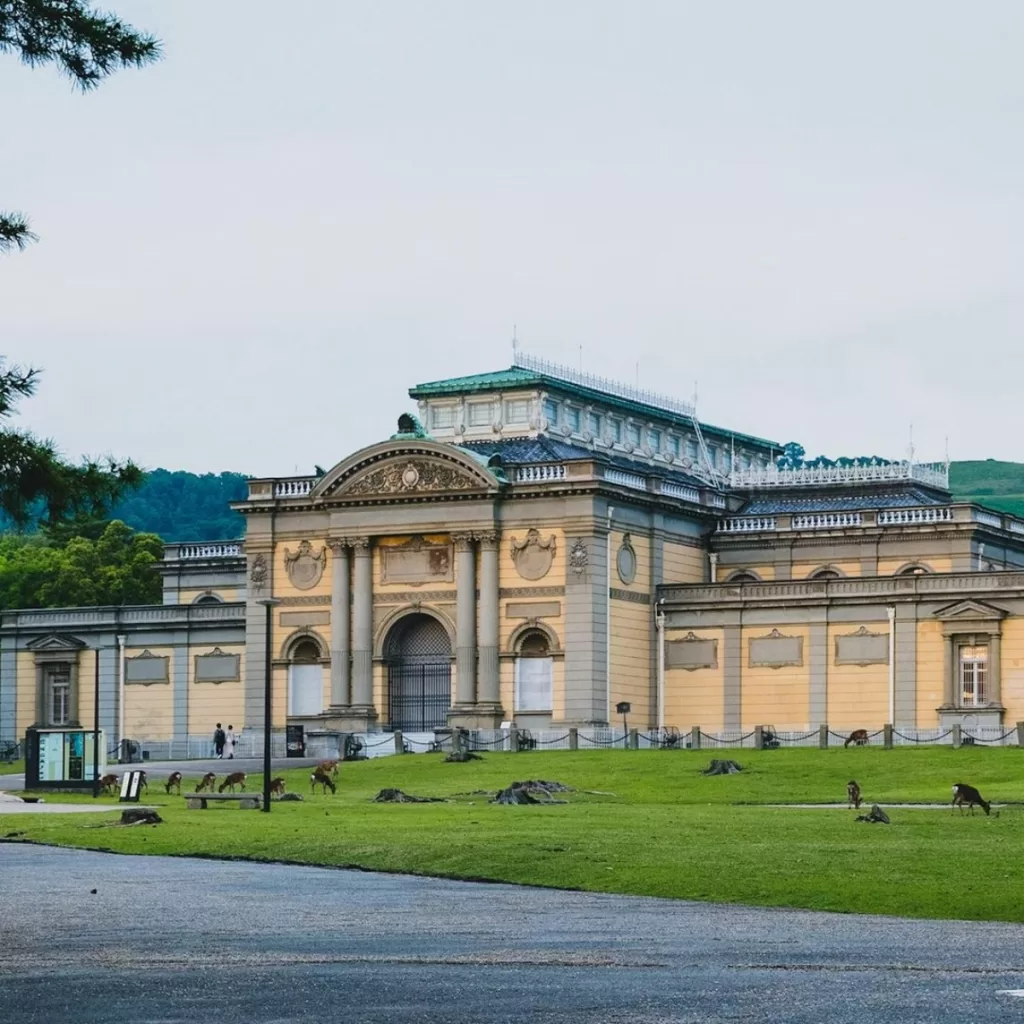
The Nara National Museum has an excellent collection of Buddhist art, statues, and artifacts. The museum provides insight into Nara’s significant role in Japan’s early cultural history and the introduction of Buddhism.
From intricately carved sculptures to exquisite paintings, visitors can witness the evolution of Buddhist art and appreciate the skill and craftsmanship of the artists. The museum houses both permanent and special exhibitions, offering a comprehensive overview of Japan’s artistic heritage.
Exploring the museum provides an opportunity to gain insight into the profound influence of Buddhism on Japanese art and culture. Visitors can immerse themselves in the rich history and religious symbolism portrayed through the exhibited artworks. The museum also provides informative displays and bilingual explanations, ensuring a meaningful experience for visitors of different backgrounds.
8. Climb up Wakakusa Mountain
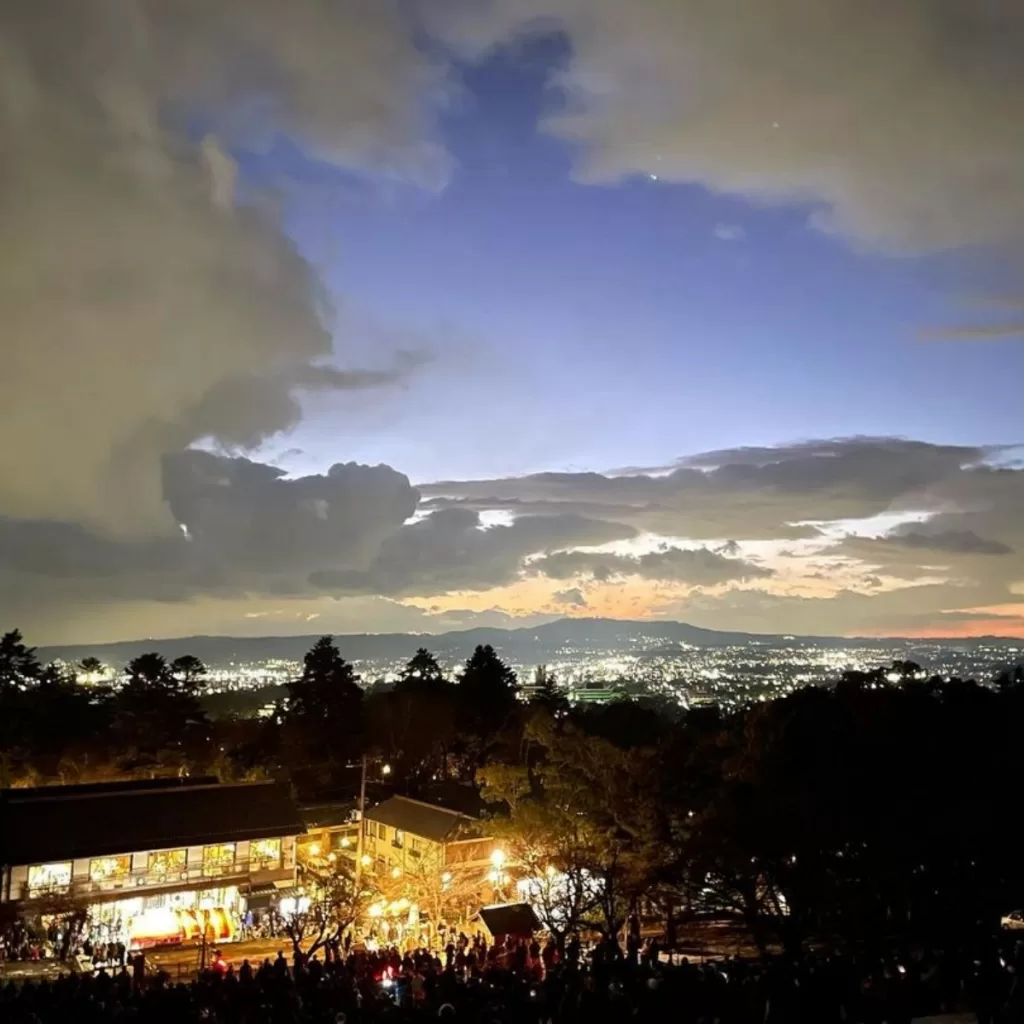
Climbing up Wakakusa Mountain is a rewarding adventure for nature lovers and outdoor enthusiasts visiting Nara. Wakakusa Mountain overlooks Nara city. The pleasant hilly climb up the mountain path takes you past parks and scenic overlooks. From the summit, you get panoramic views over Nara Park and the city.
Reaching the summit of Wakakusa Mountain is a rewarding experience. The expansive view that awaits you is truly breathtaking, allowing you to appreciate the beauty of Nara from a different perspective.
Whether you choose to hike during the day or plan a sunset climb, the scenic vistas of the city and its surrounding landscapes make the effort worthwhile.
9. Visit Yoshikien Garden
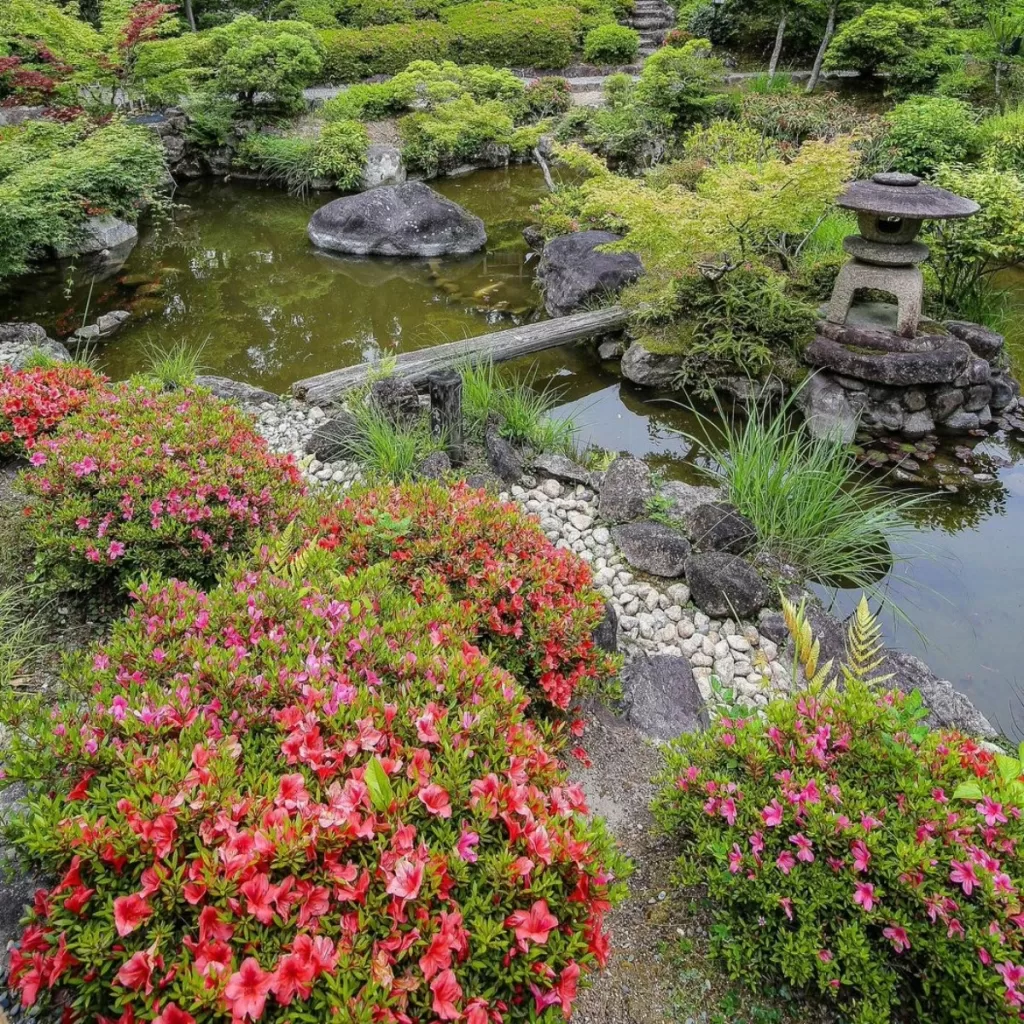
A traditional Japanese garden located in central Nara, Yoshikien has a pretty pond filled with koi fish and a tea house where you can savor green tea. It’s a nice spot for escaping the crowds.
One of the highlights of Yoshikien Garden is the opportunity to witness the seasonal beauty of nature. The garden changes its appearance throughout the year, from the vibrant cherry blossoms in spring to the fiery foliage of autumn. These seasonal transformations add an extra layer of enchantment to an already picturesque setting.
As you stroll through the garden’s carefully crafted paths, you’ll have the chance to admire various elements of traditional Japanese garden design, such as stone lanterns, small bridges, and pruned trees. These elements create a harmonious and balanced atmosphere, inviting visitors to relax and appreciate the elegance of Japanese aesthetics.
10. Shop Along Higashimuki Shopping Arcade

The covered Higashimuki Shopping Arcade near Nara Park has over 60 souvenir and snack shops. You can find Nara souvenirs, try local treats, and watch craftsmen make Japanese sweets.
From traditional Japanese crafts and souvenirs to modern fashion and accessories, you’ll find an array of unique shopping opportunities as you explore the arcade. Whether you’re looking for traditional pottery, kimono fabrics, or trendy clothing, Higashimuki Shopping Arcade has something for everyone.
In addition to shopping, the arcade is a culinary haven with numerous restaurants, cafes, and street food stalls. Food enthusiasts can indulge in delicious local specialties such as takoyaki (octopus balls), okonomiyaki (savory pancakes), and kushikatsu (deep-fried skewers). There are also charming cafes where you can relax, savor a cup of matcha tea, and enjoy delectable Japanese desserts like dorayaki (red bean pancake) or taiyaki (fish-shaped cake).
11. Eat at Nara’s Old Restaurants
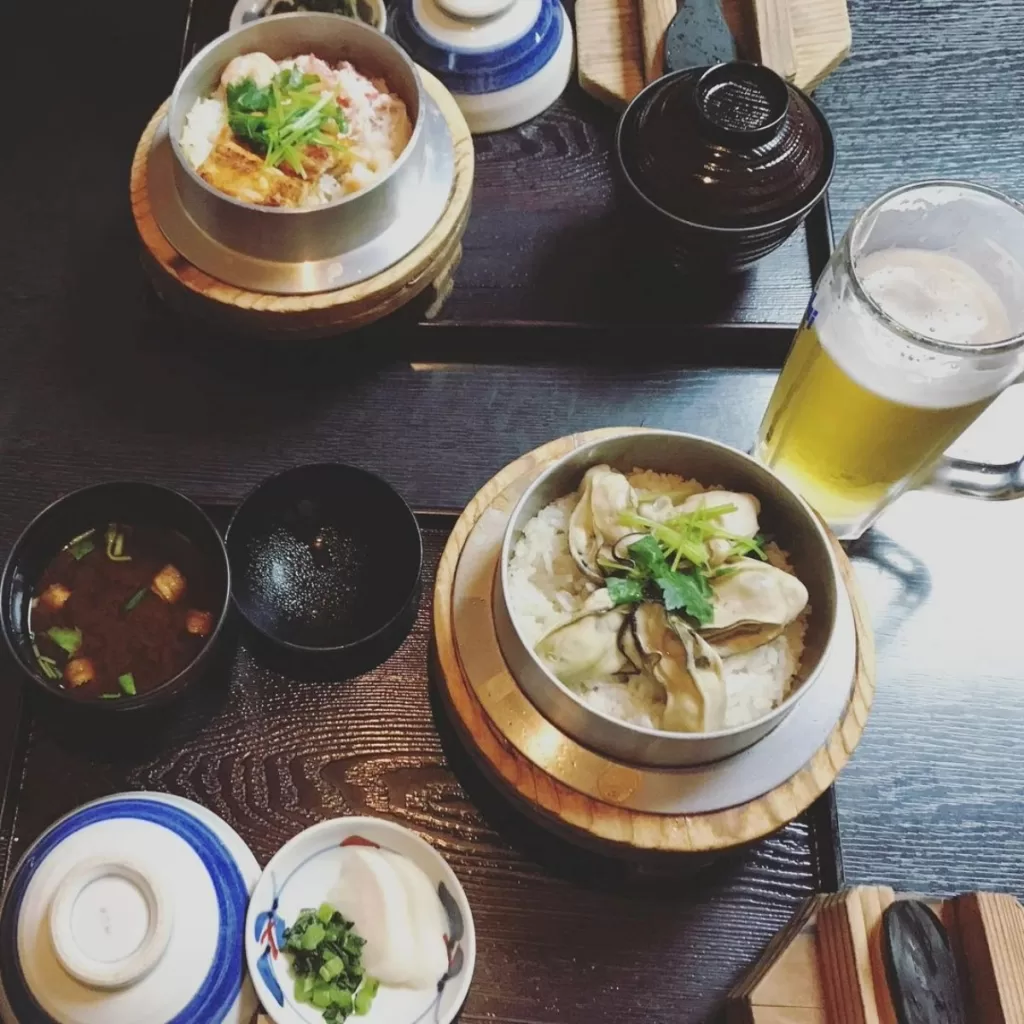
Nara has many historic restaurants and cafes that are over 100 years old. Nara-eki offers a taste of Japan’s dining history with tabla service and classic dishes.
One of the highlights of dining at Nara’s old restaurants is the opportunity to taste local specialties that have been perfected over the years. From delicate tofu dishes to hearty kaiseki meals, these restaurants offer an authentic taste of Nara’s traditional cuisine. You can indulge in local favorites like kakinoha-zushi (sushi wrapped in persimmon leaf), yudofu (hot tofu), and nama-fu (wheat gluten), which are culinary delights unique to the region.
The ambiance of these old restaurants adds to the dining experience. Many of them are housed in historic buildings, some dating back several centuries. The traditional architecture, low tables, and sliding doors create an intimate and immersive atmosphere, transporting diners to a bygone era of Nara’s cultural heritage.
12. Stay at a Temple Lodging
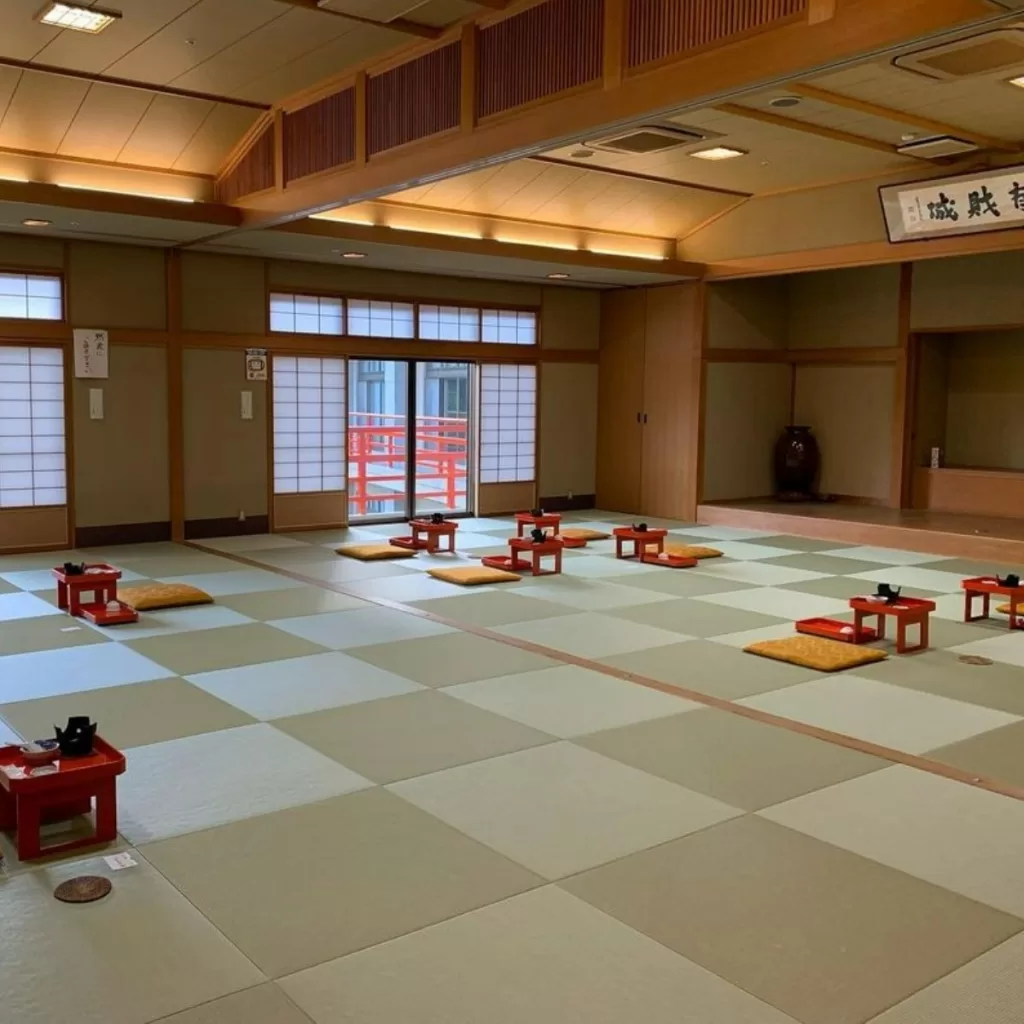
For a unique experience, stay overnight at one of Nara’s temples. You can stay at a shukubo temple lodging and dine on shojin-ryori Buddhist vegetarian cuisine.
Staying at a temple lodging in Nara provides a unique and immersive experience for travelers seeking a deep connection with Japanese culture and spirituality. Many temples in Nara offer accommodations known as shukubo, providing visitors with an opportunity to experience the peaceful and meditative atmosphere of temple life.
During your stay, you can participate in various temple activities and rituals, such as morning prayers and meditation sessions. These experiences offer an opportunity for self-reflection and a chance to immerse yourself in the spirituality and mindfulness that are integral to temple life. It’s a unique opportunity to learn about Buddhist practices and gain a deeper understanding of Japanese culture and traditions.
One of the highlights of staying at a temple lodging is the opportunity to enjoy shojin ryori, the traditional vegetarian cuisine of Buddhist monks. These meticulously prepared meals are not only delicious but also reflect the principles of simplicity and balance. By savoring these wholesome and flavorful dishes, you can experience a taste of the monastic lifestyle and embark on a culinary journey that nourishes both the body and the spirit.
13. See Isuien Garden
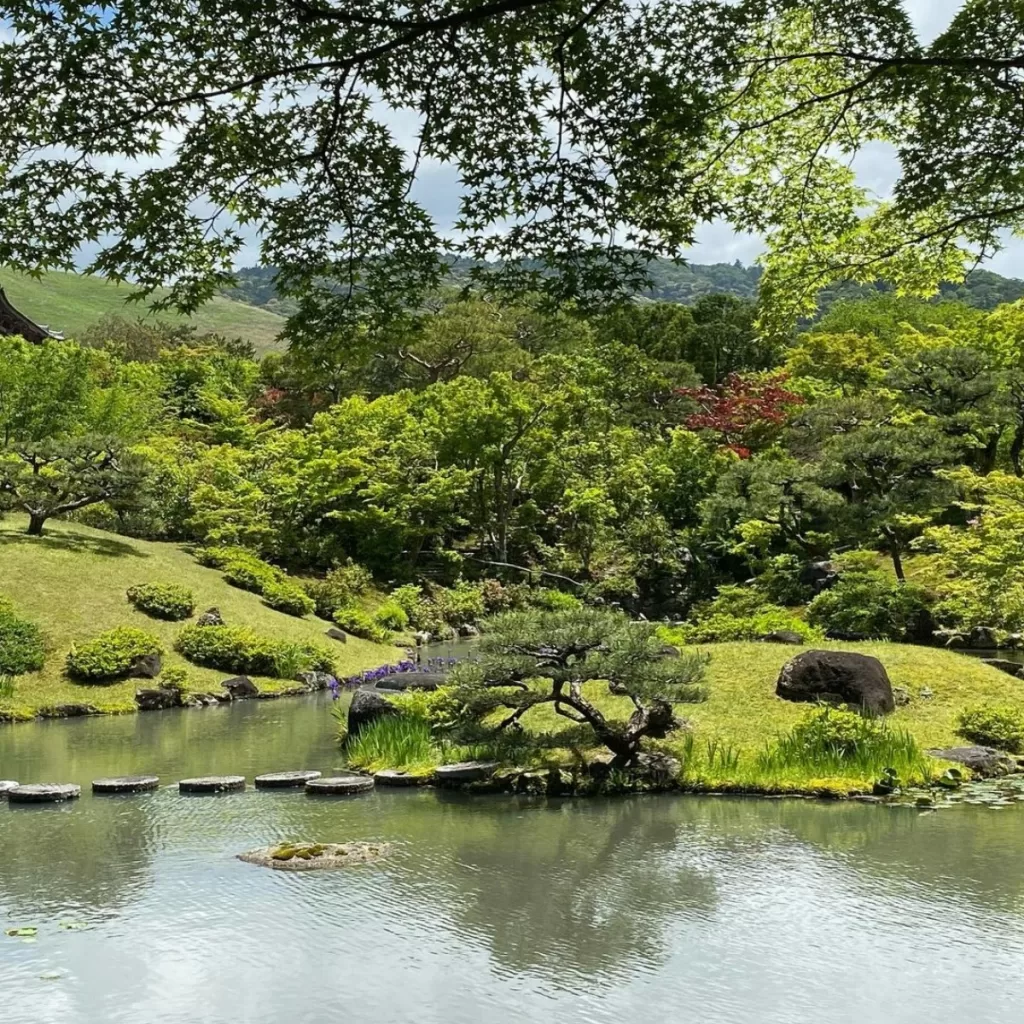
Located in central Nara, Isuien is one of the city’s finest gardens. It has two parts: a beautifully landscaped garden and traditional tea house. It’s especially lovely when the wisteria is in bloom. The front garden features an elegant pond adorned with water lilies, koi fish, and carefully placed stepping stones. The surrounding landscapes are meticulously designed to create a sense of balance and serenity, allowing visitors to find respite in the midst of nature.
One of the striking features of Isuien Garden is its integration with the surrounding hills and the Nara landscape. As you explore the garden, you’ll be treated to picturesque views of Mount Wakakusa and Nara’s ancient cityscape, creating a harmonious connection between nature and human-made beauty.
Isuien Garden’s historical significance and its careful preservation make it an invaluable cultural asset in Nara. It offers visitors a chance to appreciate the aesthetics of Japanese garden design while providing a peaceful escape from the bustling tourist areas.
14. Walk from Nara to Horyuji Temple
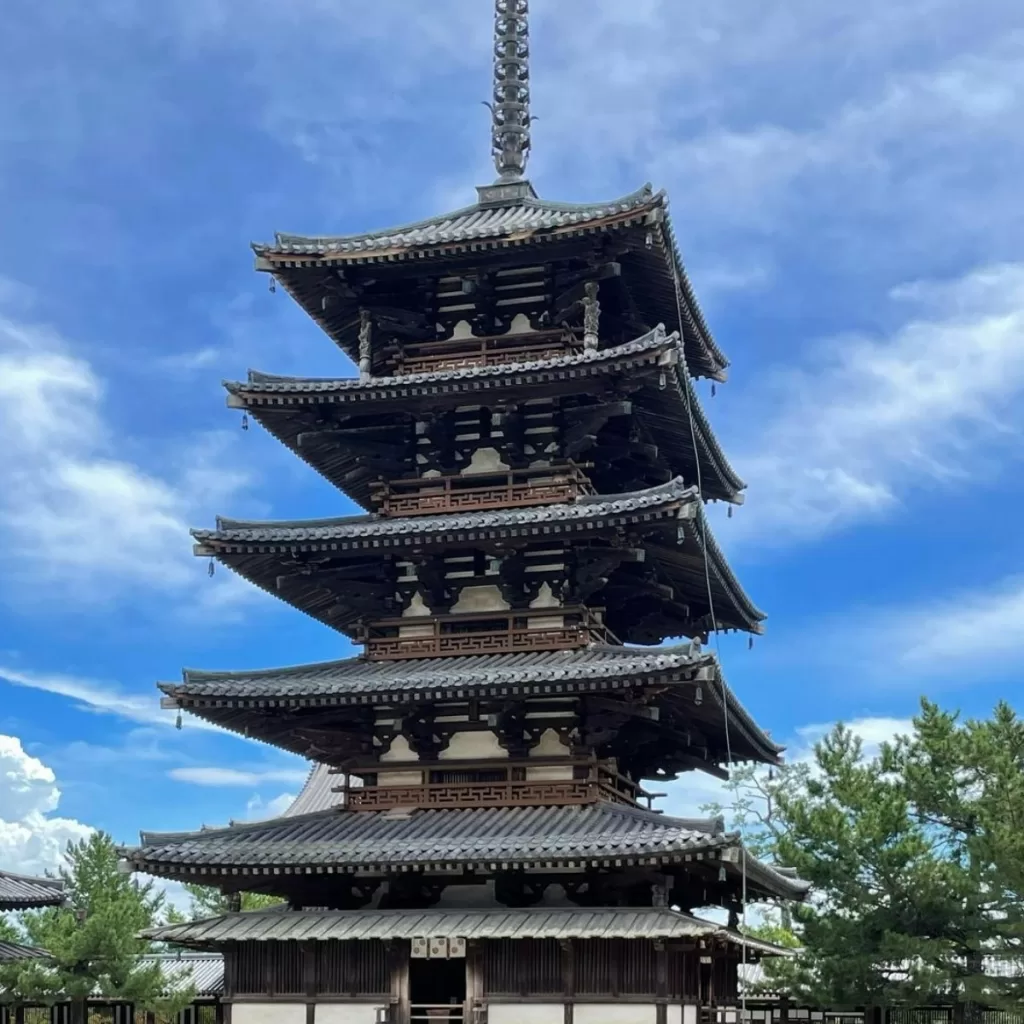
For those with more time, you can walk along ancient pilgrimage routes from Nara Park to Horyuji Temple. The walk takes about 3 hours one-way and passes smaller historic temples along the way.
Walking from Nara to Horyuji Temple is not just a physical journey but also a cultural and spiritual one. As one of Japan’s oldest wooden structures, this UNESCO World Heritage site is a treasure trove of Buddhist art and architecture. Upon reaching the temple, you will be greeted by the grandeur of the five-story pagoda, ancient halls, and the sacred atmosphere that permeates the complex. Exploring the temple grounds provides a profound glimpse into Japan’s rich religious and cultural heritage. It offers a unique opportunity to connect with nature, explore historical landmarks, and experience the serenity of temple grounds.
The combination of natural beauty, historical significance, and spiritual resonance makes this walk a truly memorable and enriching experience for those seeking a deeper understanding of Japan’s traditions and history.
15. Drink Sake made from Nara’s Water
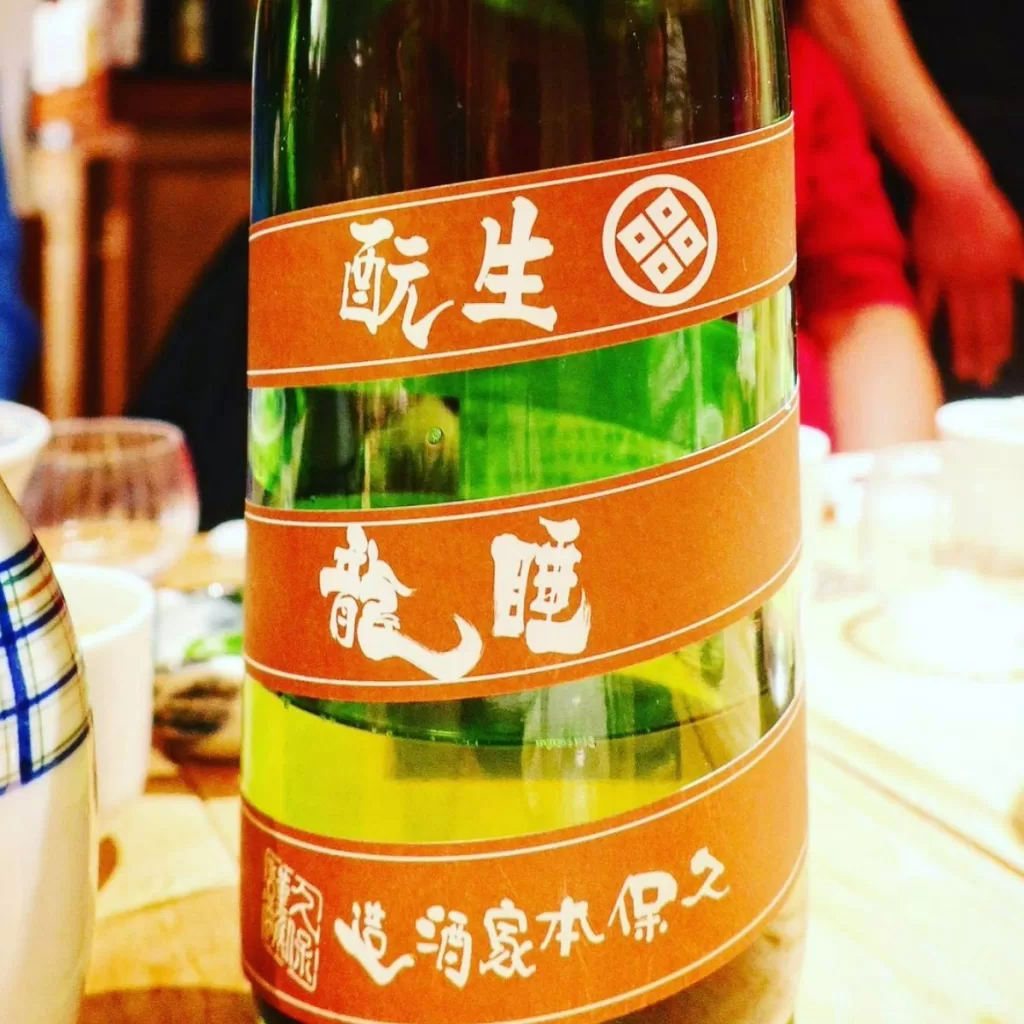
Nara’s soft water is acclaimed as among the best in Japan for sake brewing. Sample the local sake like Naramasa, or visit a Naramasa in Nara. The water in Nara is renowned for its purity and mineral content, making it perfect for producing high-quality sake. The pristine nature of the water contributes to the smoothness and clarity of the final product. When you indulge in sake made from Nara’s water, you’ll discover a distinct taste profile that is refreshing and clean.
Nara is home to several sake breweries that have been perfecting their craft for generations. These breweries take advantage of the local water source, using traditional brewing methods combined with modern technology to create sake of exceptional quality.
Visiting one of these breweries provides an opportunity to learn about the sake-making process, from rice cultivation to fermentation and aging. Drinking sake made from Nara’s water allows you to savor the flavors of the region and appreciate the artistry that goes into its production. Each sip reveals the intricate balance of sweetness, acidity, and umami flavors that are characteristic of Nara’s sake.
16. See Yakushiji Temple
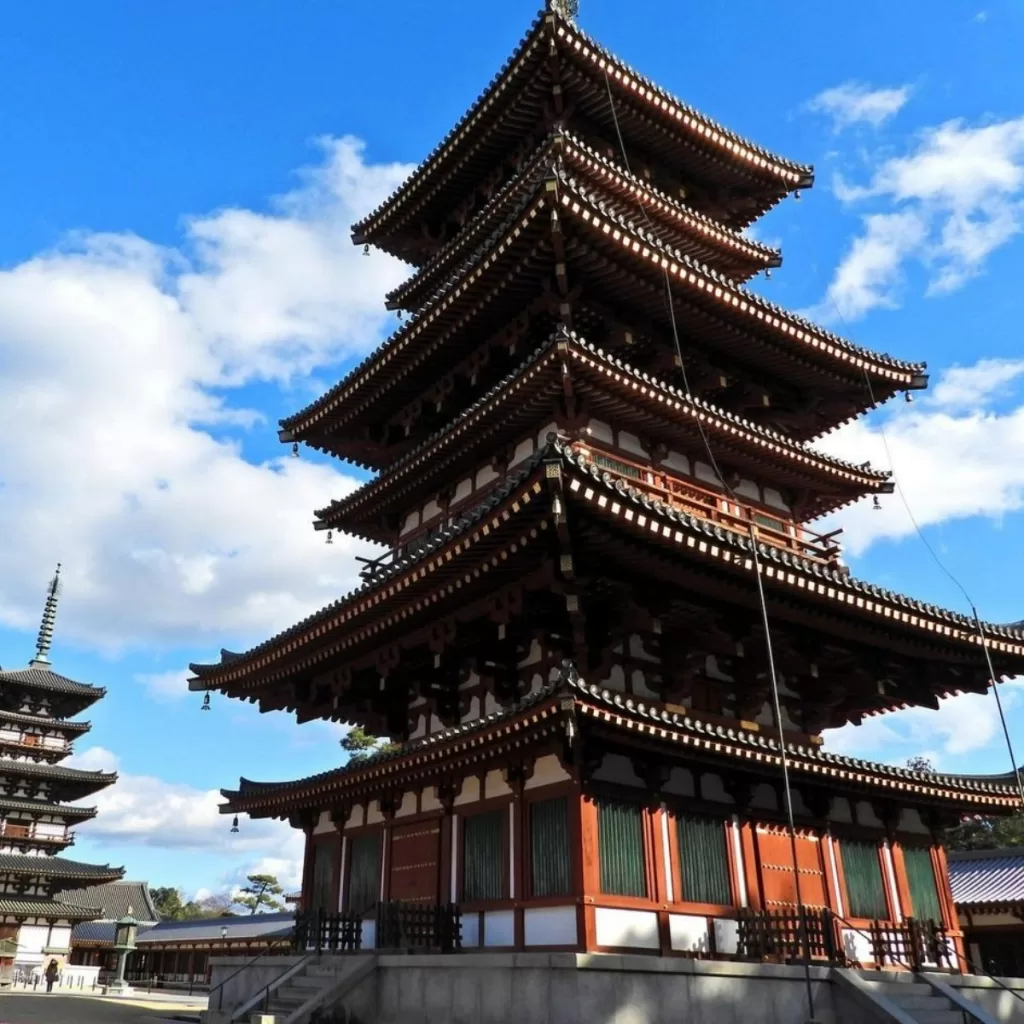
Founded in 680, Yakushiji Temple is one of the oldest and most influential Buddhist temples in Japan. It houses important Buddhist statues that date back to the 8th century.
Upon entering Yakushiji Temple, you are greeted by the majestic East Pagoda, a towering structure that stands as a testament to the temple’s ancient grandeur. The pagoda, with its intricate architectural details and imposing presence, never fails to impress visitors. It is one of the oldest surviving wooden pagodas in Japan and offers a glimpse into the craftsmanship and architectural ingenuity of the era.
As you stroll through the temple grounds, you’ll encounter various other structures, including the Main Hall and the Lecture Hall. These buildings showcase the distinct architectural style of the Nara period, with their symmetrical layouts, elegant lines, and exquisite details.
17. Visit Toshodaiji Temple
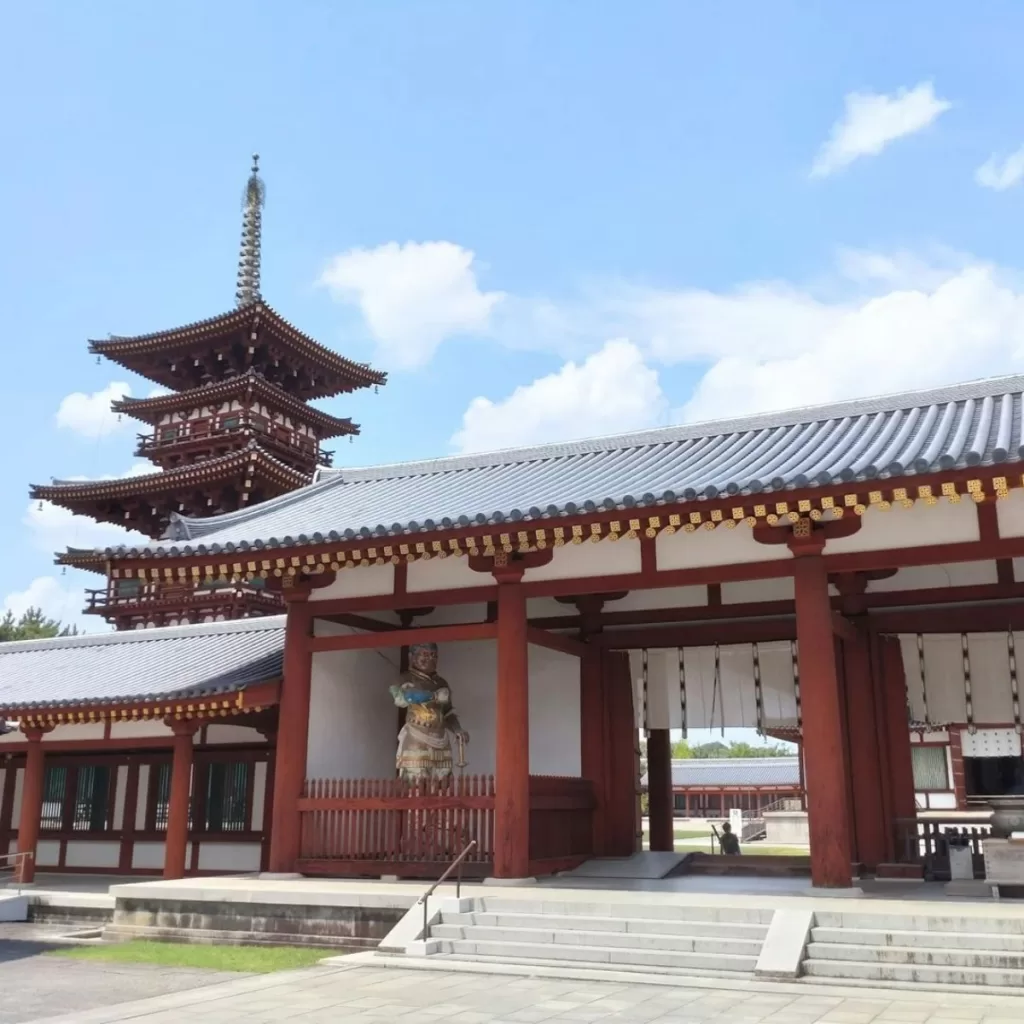
Toshodaiji is known for its large open grounds and Kondo Hall, which has vibrantly decorated interiors. It enshrines the founder of the Kegon school of Buddhism in Japan.
One of the highlights of a visit to Toshodaiji Temple is the opportunity to view the famous Maitreya Buddha statue. This awe-inspiring bronze statue, standing at over 10 meters tall, is considered one of the largest of its kind in Japan. The serene expression and majestic presence of the statue create a profound sense of awe and reverence for the Buddhist teachings it represents.
The temple grounds also feature a beautiful garden that offers a moment of respite and contemplation. The meticulously maintained landscapes, adorned with seasonal flowers and tranquil ponds, create a harmonious backdrop for reflection and appreciation of nature’s beauty.
18. Explore Heijo Palace Site
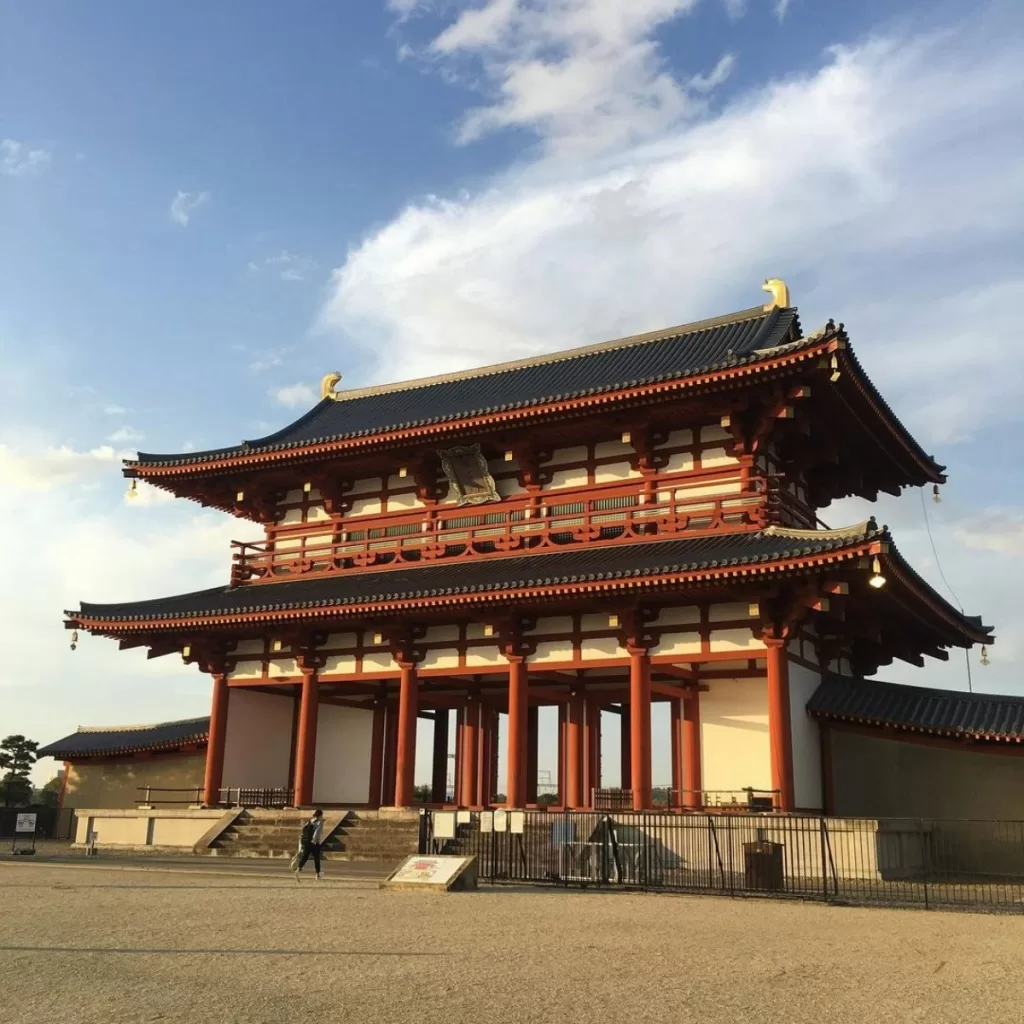
Heijo Palace was the palace of the Emperor during the Nara Period when Nara was Japan’s capital. Sections of the former palace grounds and gates have been restored and converted into a park.
The expansive site of Heijo Palace allows visitors to immerse themselves in the remnants of Japan’s imperial past. As you wander through the ruins, you’ll encounter reconstructed buildings, such as the Daigokuden (the main hall), which give you a sense of the scale and architectural splendor that once graced this magnificent complex.
The layout of Heijo Palace Site is meticulously planned and symbolizes the power and influence of the imperial government during that era. The vast courtyards, grand avenues, and immaculately designed gardens offer a glimpse into the opulence and sophistication of Heian society.
19. Eat Kakinoha Sushi
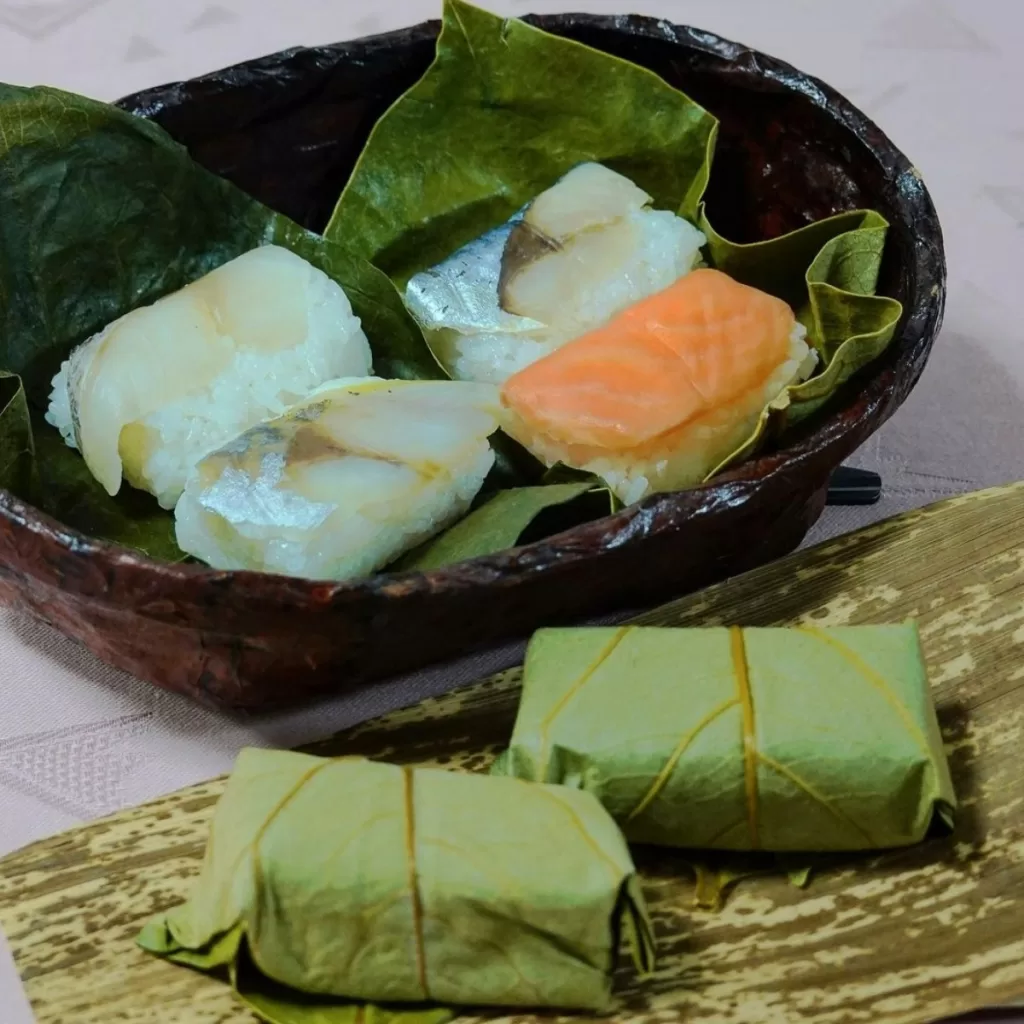
Nara is known for kakinoha sushi – sushi rice wrapped in persimmon leaves. The local style sushi is found at restaurants around town. Kakinoha Sushi, also known as sushi wrapped in persimmon leaf, is a traditional dish that has been enjoyed in Nara for centuries.
The highlight of Kakinoha Sushi is the aromatic and slightly sweet flavor that the persimmon leaf imparts to the rice and fillings. The leaf not only adds a distinctive taste but also acts as a natural preservative, keeping the sushi fresh and enhancing its overall presentation. With each bite, you’ll experience a flavorful combination of vinegared rice, fresh ingredients, and the subtle essence of the persimmon leaf.
Nara’s Kakinoha Sushi showcases a variety of fillings, including fresh seafood, vegetables, and even local delicacies. From succulent raw fish to vibrant and crunchy vegetables, the diverse options cater to a range of tastes and preferences. Each piece is expertly crafted, ensuring a balanced and harmonious blend of flavors.
20. See Ukimido Gazebo
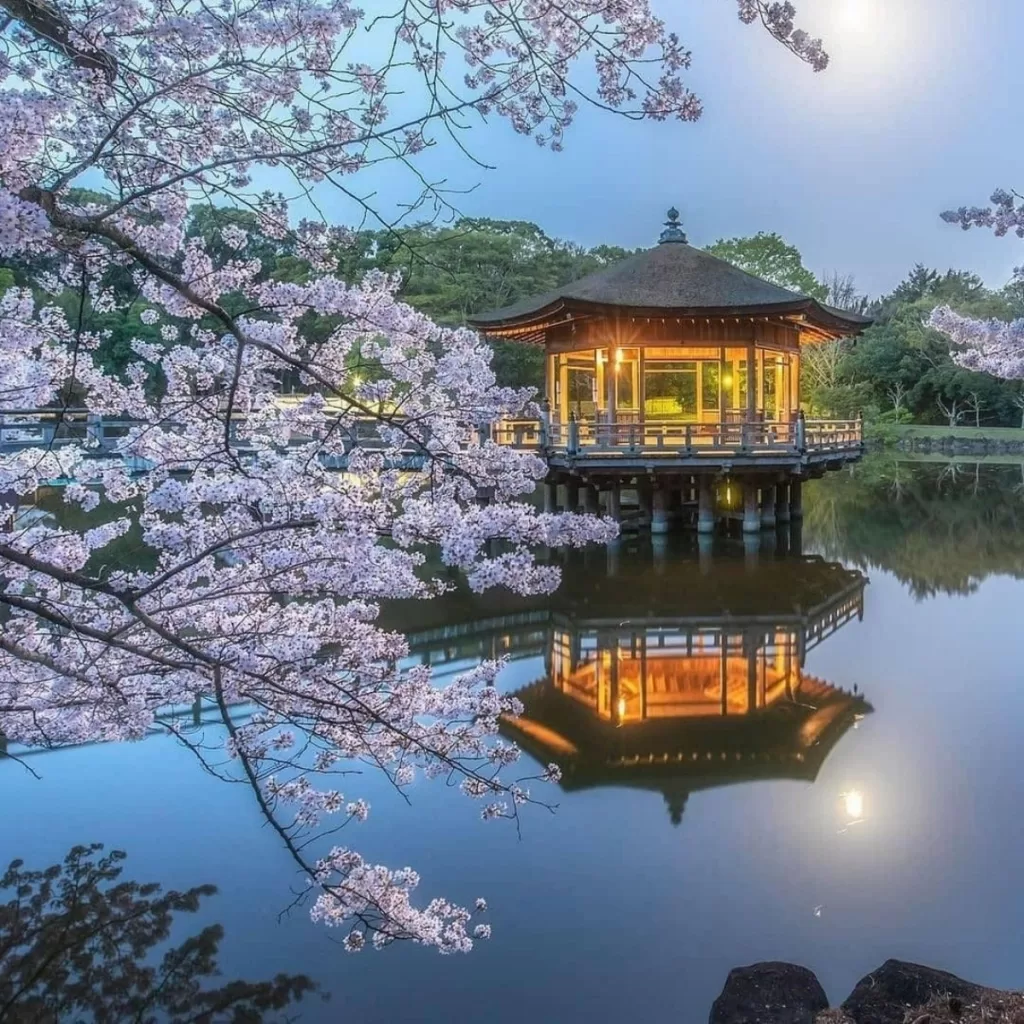
Overlooking a lotus pond, the Ukimido Gazebo was built in 1895 and offers scenic views of water lilies and Sagi Ike pond. It’s a calming place to relax.
The Ukimido Gazebo is especially captivating during the cherry blossom season when the cherry trees lining the pond burst into vibrant hues of pink. The reflection of the blossoms on the water creates a mesmerizing scene that attracts locals and tourists alike. It’s a popular spot for hanami (flower viewing) picnics, providing an idyllic setting to appreciate the ephemeral beauty of Japan’s iconic sakura.
As you approach the gazebo, you’ll notice its open architectural design, allowing visitors to feel as though they are connected to the surrounding nature. Inside, the Ukimido Gazebo offers a peaceful and contemplative space for prayer or quiet reflection. The gentle sound of rippling water and the soft rustle of leaves add to the serene ambiance, creating a sense of harmony and tranquility.
21. Visit Sangatsudo Hall
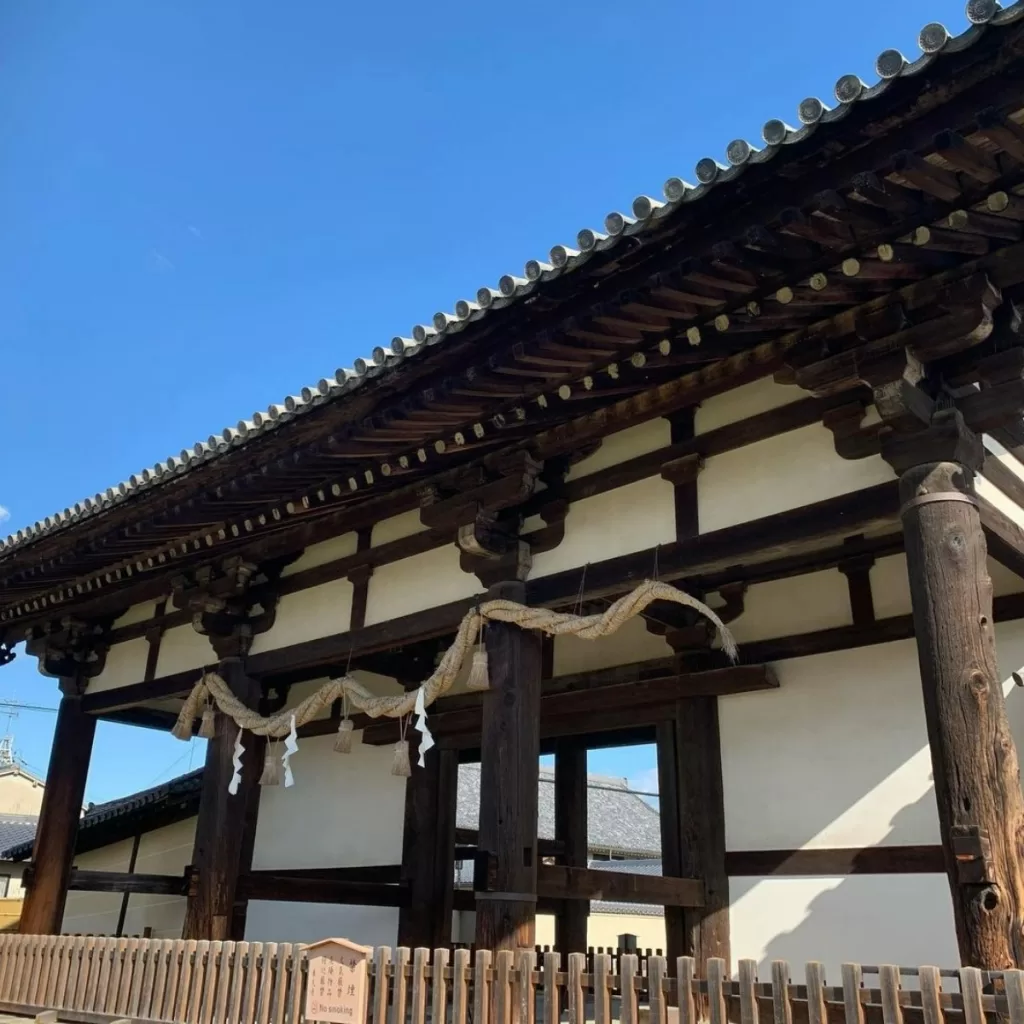
This small hall near Todaiji Temple dates back to 733 AD. Its ornate wooden architecture with lacquered pillars shows the skill of early Japanese craftsmen.
Sangatsudo Hall hosts important Buddhist rituals and ceremonies throughout the year. The hall’s construction dates back to the 8th century, making it a significant historical and cultural landmark. Its architectural design reflects the exquisite craftsmanship and attention to detail of the Nara period, with intricate wooden carvings and graceful lines that showcase the mastery of ancient Japanese artisans.
Visiting Sangatsudo Hall in Nara is not only a chance to appreciate the architectural brilliance and artistic treasures of ancient Japan but also an opportunity to connect with the profound spiritual traditions that have shaped the country’s culture.
22. Explore Himuro Shrine
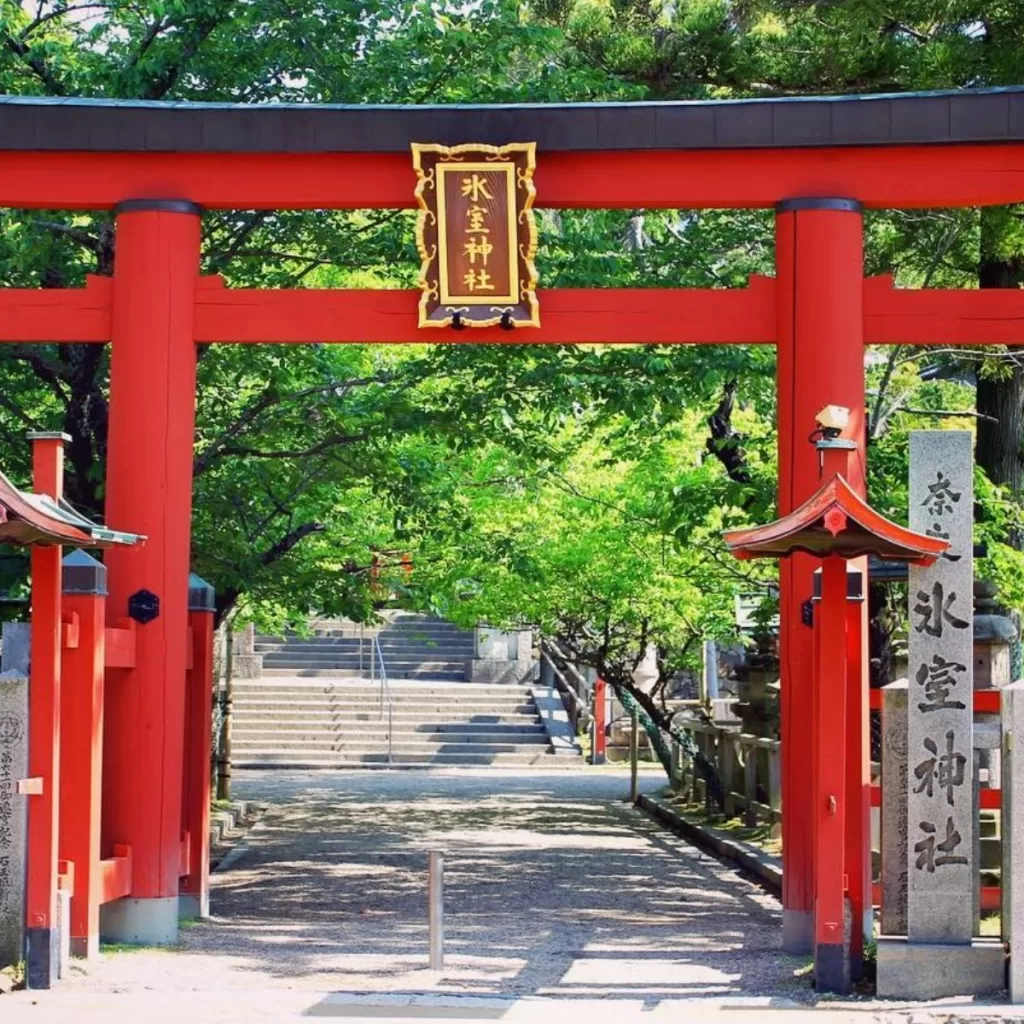
Himuro Shrine originated during the founding of Kyoto over 1,300 years ago. The unique wooden lattice gates and open hall design are worth seeing.
One of the highlights of exploring Himuro Shrine is its unique connection to winter and snow. The shrine is dedicated to Himuro no Okami, the deity believed to govern snow and protect against cold-related illnesses. In winter, the shrine becomes particularly enchanting as it is adorned with beautiful snow and ice sculptures. These intricate creations are a sight to behold and add a touch of magic to the serene surroundings.
The shrine hosts various events throughout the year, including purification rituals and seasonal festivals, which offer insights into the vibrant and rich tapestry of Shinto practices. Observing or participating in these rituals allows visitors to connect with the ancient spiritual traditions that are still alive in Japan today.
23. Try Local Crafts
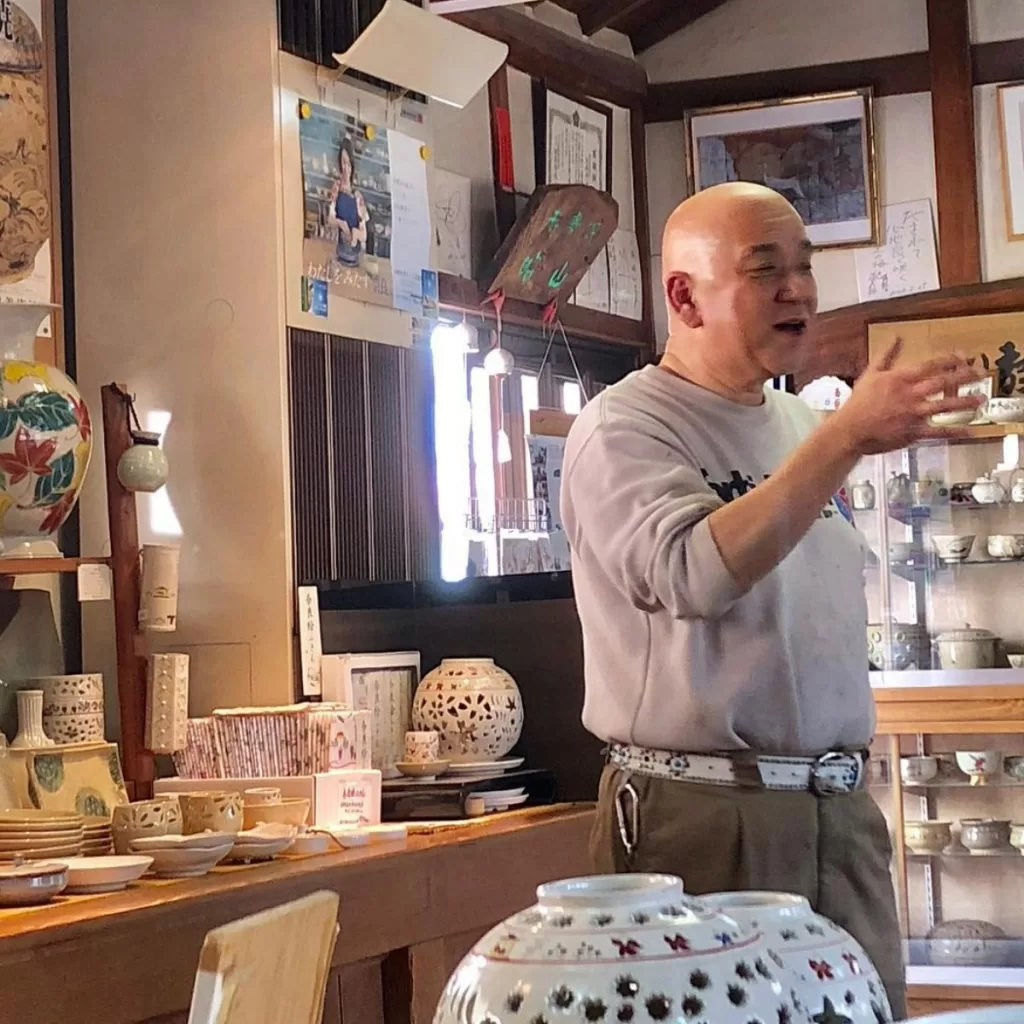
Nara is known for its handmade crafts like Akahadayaki pottery, Nara Sarashi textiles, and Nara inkstones used in calligraphy. Find locally made craft items at shops in Naramachi.
Trying local crafts in Nara offers a hands-on way to engage with the cultural heritage and artistic traditions of the region. It allows you to learn from skilled artisans, create something unique, and take home a special memento from your visit.
Whether you’re a craft enthusiast, an art lover, or simply keen to experience the beauty of handmade goods, exploring Nara’s local crafts is a rewarding and enriching experience.